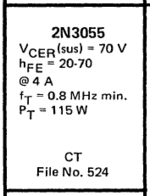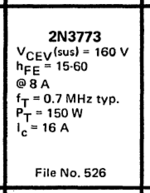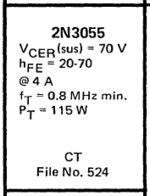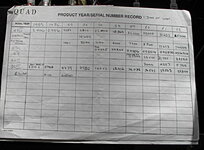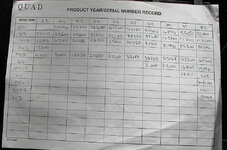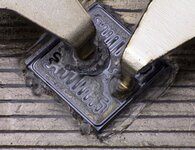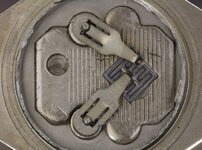Working on the upstream transistors.
My aim is to determine a ratio of the upstream transistors fT to the power transistor's fT. Once I have the original ratio order, I should be able to determine the currently available components that offer the same order of ratio. Well at least that is the plan!
TR100
This transistor was a BC154 in a resin case. Towers shows the following data for this to be as follows:

The fT value for the tranny is shown as being 40 MHz minimum this being at 1mA which is not what I can use.

The equivalent 2N4967 has a minimum fT value of 40Mhz and the BC209 datasheet shows 200 Mhz at 10mA and 5V (which is my parameter guideline)

TR101
The transistor is a BC109 NPN and in a TO-18; SOT-18 metal case. The fT value is found to be 100 Mhz at 10mA and 5V

I double checked with the 2Nxxxx equivalents as listed by Towers and these are all 100 MHz or less. So we can use the value of 100MHz as the correct fT value for this original transistor.
TR102/TR103
This transistor is a U17219 in a TO-18 metal case. I cannot find a datasheet for this NPN transistor. Many references state that a BC546B is a suitable replacement.
Going back as far as I could I could find fT data on the same family namely the BC547 and BC548 in Towers. This is shown below.

The BC546 should be a higher voltage value transistor of the same family. The fT value for the family is shown as being 150 MHz minimum. Looking at the old 2N5818 datasheet as shown below, the graph shows a fT at 10mA at 2V as being 137 MHz. Not something I can use at the moment with my little bag of knowledge. Maybe there is a known ratio of fT to voltage at the same current value I can use. Anyway ... this is the way we learn!
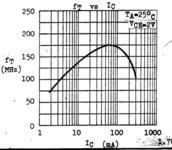 EDIT:
EDIT:
Found an old Micro Electronics datasheet for the BC546 which shows the fT to be 250 MHz.:


TR104
This transistor is a U17229 and in a TO-18; SOT-18 metal case.
The recommended replacement for this is a BC556. Looking into the vintage version of the BC556 I see Towers only listed the BC557 and BC558.

The BC556 should be a lower voltage value transistor of the same family. The fT value for the family is shown as being 75 MHz minimum.
Looking at the equivalent 2N6015 specifications as found in the General Electric Semiconductor Data Book of 1971, the following is shown.
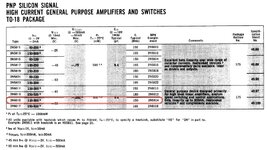
The typical fT is indicated as 150 Mhz.
TR105
This transistor is a 38496 and in a TO-39 metal case.
The recommended replacement for this the PNP transistor, BC461. Looking into the vintage version of the BC461 I see Towers shows the following specifications:

The fT minimum value is shown as 50MHz.
Somehow some kind of penny dropped now ... why is the minimum value always listed? Surely then this must be the important design value? Need to check up on this!
The SGS Databook of 1975 shows the following fT for the BC461.

The 1978 Micro Electronics datasheet indicates the following graph for the BC461:

It shows that at 10mA and 4 Volts the fT is 100Mhz.
TR106
This transistor is a 38496 and in a TO-39 metal case.
The recommended replacement for this is the NPN transistor, BC441. This is the complimentary transistor of the BC461.
All the old specification sheets list the BC461 and BC4441 together and having the same specifications.
I will deduce that the minimum fT is therefore 50 MHz and 100MHz at 10mA and 4V.

